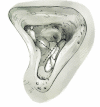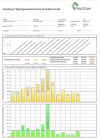Perspectives in vestibular diagnostics and therapy
- PMID: 22558055
- PMCID: PMC3341582
- DOI: 10.3205/cto000078
Perspectives in vestibular diagnostics and therapy
Abstract
Vestibular diagnostics and therapy ist the mirror of technological, scientific and socio-economics trends as are other fields of clinical medicine. These trends have led to a substantial diversification of the field of neurotology.The improvements in diagnostics have been characterized by the introduction of new receptor testing tools (e.g., VEMPs), progress in imaging (e.g., the endolymphatic hydrops) and in the description of central-vestibular neuroplasticity. The etiopathology of vestibular disorders has been updated by geneticists (e.g., the description of the COCH gene mutations), the detection of structural abnormalities (e.g., dehiscence syndromes) and related disorders (e.g. migraine-associated vertigo). The therapeutic options were extended by re-evaluation of techniques known a long time ago (e.g., saccus exposure), the development of new approaches (e.g., dehiscence repair) and the introduction of new drug therapy concepts (e.g., local drug delivery). Implantable, neuroprosthetic solutions have not yet reached experimental safety and validity and are still far away. However, externally worn neuroprosthetic solution were introduced in the rehab of vestibular disorders (e.g., VertiGuard system).These and related trends point into a medical future which is characterized by presbyvertigo as classical sign of the demographic changes ahead, by shortage of financial resources and a medico-legally over-regulated, even hostile environment for physicians in clinical medicine.
Keywords: Vestibular diagnostics; neurofeedback training; presbyvertigo; vestibular therapy.
Figures






Similar articles
-
[Perspectives in neurotology].Laryngorhinootologie. 2011 Mar;90 Suppl 1:S35-43. doi: 10.1055/s-0030-1270446. Epub 2011 Apr 26. Laryngorhinootologie. 2011. PMID: 21523632 Review. German.
-
Clinical application of vestibular evoked myogenic potential (VEMP).Auris Nasus Larynx. 2016 Aug;43(4):367-76. doi: 10.1016/j.anl.2015.12.006. Epub 2016 Jan 11. Auris Nasus Larynx. 2016. PMID: 26791591 Review.
-
Current diagnostic procedures for diagnosing vertigo and dizziness.GMS Curr Top Otorhinolaryngol Head Neck Surg. 2017 Dec 18;16:Doc02. doi: 10.3205/cto000141. eCollection 2017. GMS Curr Top Otorhinolaryngol Head Neck Surg. 2017. PMID: 29279722 Free PMC article. Review.
-
Clinical high-resolution imaging and grading of endolymphatic hydrops in Hydropic Ear Disease at 1.5 T using the two-slice grading for vestibular endolymphatic hydrops in less than 10 min.Eur Arch Otorhinolaryngol. 2022 Feb;279(2):751-757. doi: 10.1007/s00405-021-06731-7. Epub 2021 Mar 9. Eur Arch Otorhinolaryngol. 2022. PMID: 33687507
-
Endolympathic hydrops in patients with vestibular schwannoma: visualization by non-contrast-enhanced 3D FLAIR.Neuroradiology. 2011 Dec;53(12):1009-15. doi: 10.1007/s00234-010-0834-y. Epub 2011 Jan 11. Neuroradiology. 2011. PMID: 21221556
References
-
- Andreas M, Debong B, Bruns W. Handbuch Arztrecht. Baden-Baden: Nomos;
-
- Allum JHJ, Carpenter MG. A speedy solution for balance and gait analysis: angular velocity measured at the centre of body mass. Current opinion in Neurology. 2005;18:15–21. Available from: http://dx.doi.org/10.1097/00019052-200502000-00005. - DOI - PubMed
-
- Helling K. Funktionsstörungen der Otolithenorgane: Klinische Aspekte und Therapieoptionen. HNO. 2008;56:996–1002. Available from: http://dx.doi.org/10.1007/s00106-008-1806-y. - DOI - PubMed
-
- Halmagyi GM, Weber KP, Curthoys IS. Vestibular function after acute vestibular neuritis. Restor Neurol Neurosci. 2010;28:37–46. - PubMed
-
- Halmagyi GM, Curthoys IS. A clinical sign of canal paresis. Arch Neurol. 1998;45:737–739. Available from: http://dx.doi.org/10.1001/archneur.1988.00520310043015. - DOI - PubMed
LinkOut - more resources
Full Text Sources

